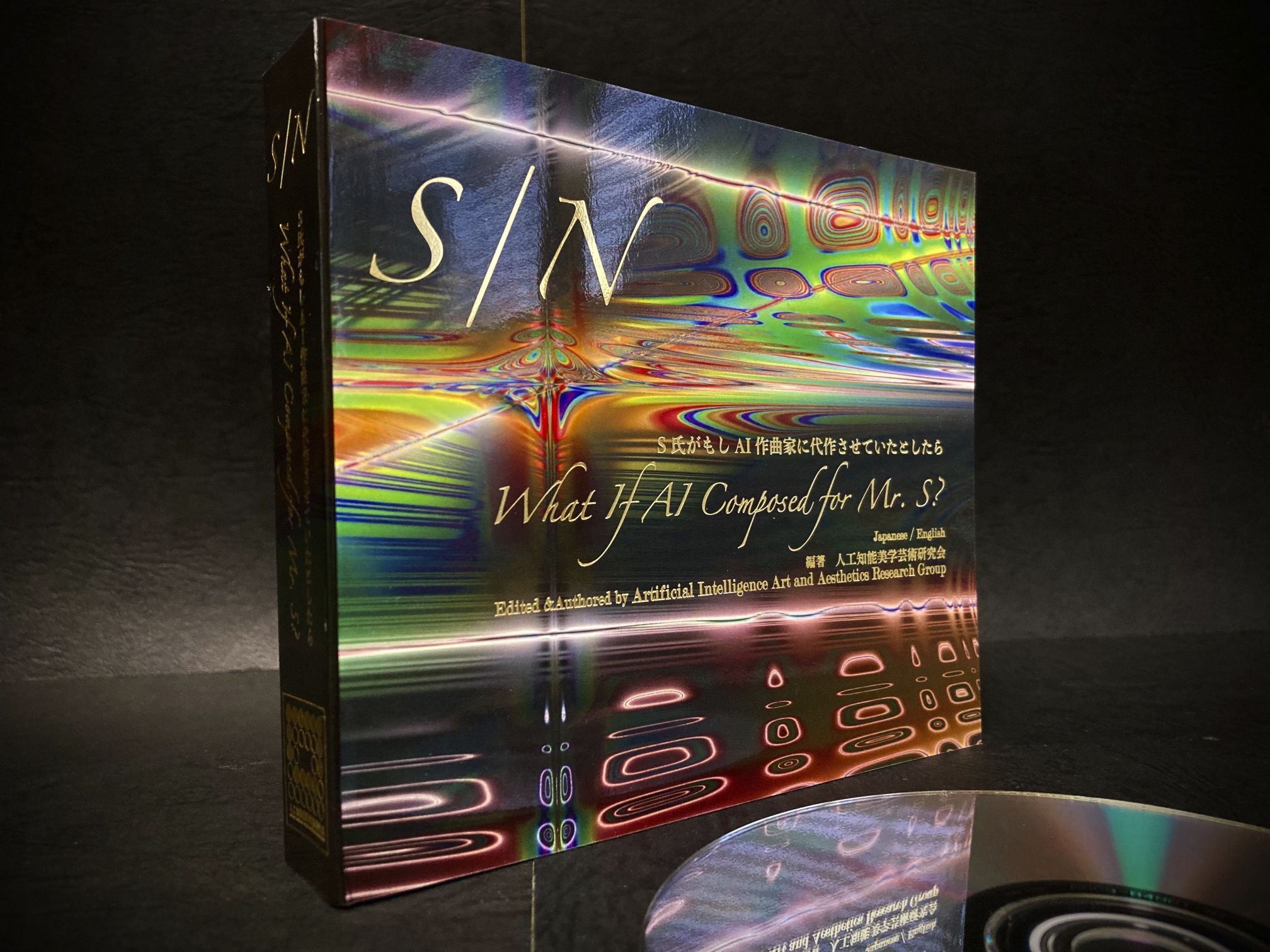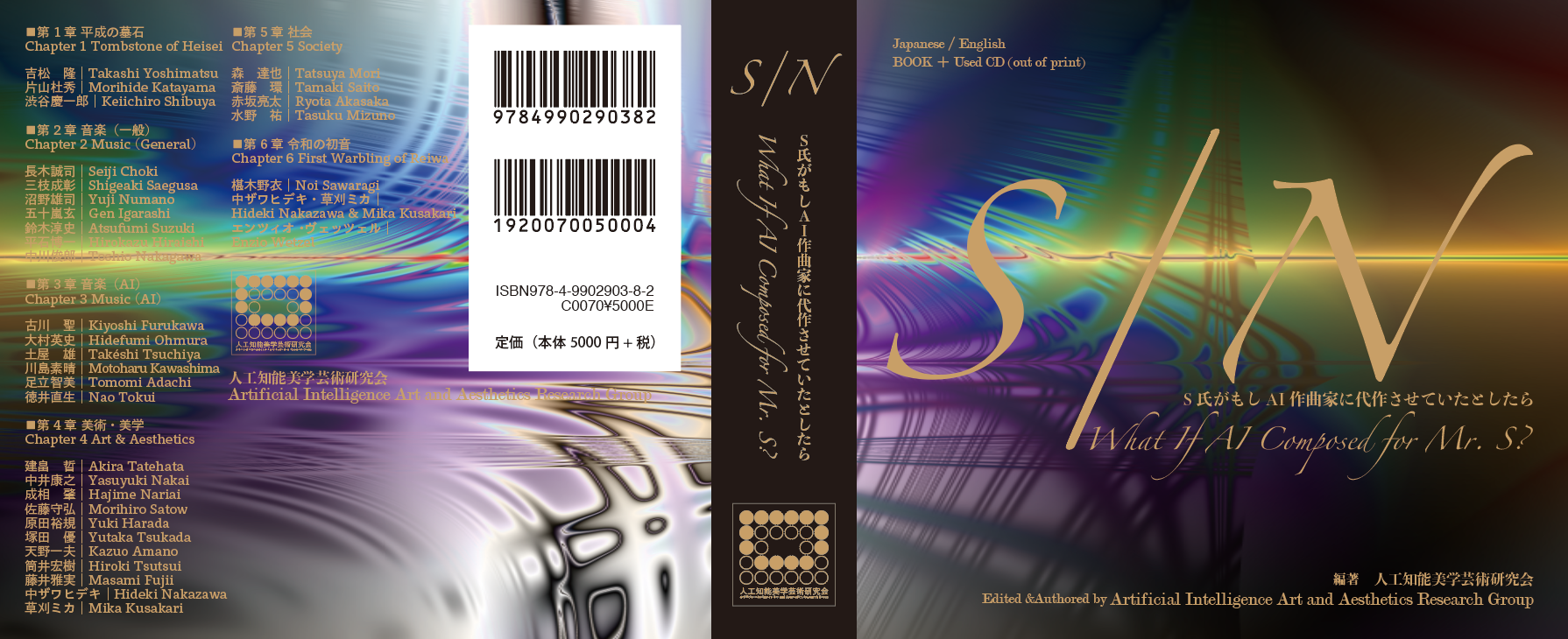Artificial Intelligence Art and Aesthetics Research Group (AIAARG)
日本語 / English
S/N
What If AI Composed for Mr. S?



- 5,500 JPY (including tax) / 5,000 JPY (pre-tax price)
- Bilingual (English/Japanese) / BOOK + Used CD (out of print)
-
Online Selling:
Amazon Japan www.amazon.co.jp/dp/4990290380/
Amazon USA www.amazon.com/dp/4990290380/
NADiff Online http://www.nadiff-online.com/?pid=157316649 [J]
-
Book Stores in Japan:
NADiff a/p/a/r/t
On Sundays
* To bookstores: We can manage consignment sale. Email at info [at] aibigeiken.com .
-
[Lead]
- Mr. S and Mr. N are real characters. Mr. S had asked Mr. N to compose music based on his “instruction sheets,” and Mr. N had long served as his ghostwriter. Meanwhile, Mr. S had proclaimed that he is completely deaf so that he composes musical pieces note by note from his innermost core. The resulting “Symphony No. 1” attracted a far greater number of majority who admired the piece, with some even moved to tears, than a very selective minority who expressed strong hatred, but the success was later turned over into a scandal as Mr. N revealed his engagement as the ghostwriter.
We AIAARG (Artificial Intelligence Art and Aesthetics Research Group) do not see this case just in the framework of a lawsuit.
Rather, we see it as a testcase that poses questions like “What if Mr. S employed AI, instead of a human specialist, to compose for him? Then how would it matter? Or nothing matters?” Of course it is possible to claim that the unique talent of Mr. N is irreplaceable, but the case can remind us of different perspectives, such as the creativity of Mr. S' “instruction sheet” itself, or the contingent status of authorship made explicit by the intervention of AI as the Other/technology.
* Related to the participation in the exhibition “Bubbles/Debris: Art of the Heisei Period 1989-2019” curated and supervised by Noi Sawaragi held at Kyoto City KYOCERA Museum of Art from January 23 to April 11th, 2021.
- Mr. S and Mr. N are real characters. Mr. S had asked Mr. N to compose music based on his “instruction sheets,” and Mr. N had long served as his ghostwriter. Meanwhile, Mr. S had proclaimed that he is completely deaf so that he composes musical pieces note by note from his innermost core. The resulting “Symphony No. 1” attracted a far greater number of majority who admired the piece, with some even moved to tears, than a very selective minority who expressed strong hatred, but the success was later turned over into a scandal as Mr. N revealed his engagement as the ghostwriter.
-
[Summary]
- This book is an attempt to get to a certain kind of the essence of art and aesthetics that can be read from the secret distortions of creation and appreciation in the early 21st century. The subject is the “ghostwriter case” between Mamoru Samuragochi (Mr. S) and Takashi Niigaki (Mr. N), which caused a scandal in 2014. The era-specific factor assumed here is the technology or the Other called “artificial intelligence” (AI), which has been making great strides since 2012 and is known as the 3rd boom.
In this ghostwriter case, the modern “composition = creation,” which should be attributed to an individual artist, was divided into two parts (S/N): “the creation of Mr. S, who does not write notes but writes instructions,” and “the creation of Mr. N, who writes notes from instructions.” As the word ghostwriting indicates, in common sense, the actual creation in this case can be attributed to Mr. N who wrote the notes. However, in recent years, automatic composition technology by AI can replace Mr. N's creativity in terms of the division of roles, but not that of Mr. S. From this point, the question arises, “What If AI Composed for Mr. S?”
This book contains the responses of 33 experts from various fields to this question.
- This book is an attempt to get to a certain kind of the essence of art and aesthetics that can be read from the secret distortions of creation and appreciation in the early 21st century. The subject is the “ghostwriter case” between Mamoru Samuragochi (Mr. S) and Takashi Niigaki (Mr. N), which caused a scandal in 2014. The era-specific factor assumed here is the technology or the Other called “artificial intelligence” (AI), which has been making great strides since 2012 and is known as the 3rd boom.
-
[Basic Information]
-
Book Title | S/N: What If AI Composed for Mr. S?
Editor/Author/Publisher | Artificial Intelligence Art and Aesthetics Research Group
In Collaboration with Goethe-Institut Osaka Kyoto
Date of Issue | January 23, 2021 (On-sale Date | March 11, 2021)
Bilingual (English/Japanese) / BOOK + Used CD (out of print) / 4.9 x 5.6 inches / 448 pages / with a luxury case
ISBN | 978-4-9902903-8-2
Antique Dealer License | No. 303332007000, Tokyo Metropolitan Government Public Safety Commission
* Privilege: 2 Discount Coupons for AI Art & Aesthetics Research Meeting (only 1 coupon per meeting can be used for 500 yen)
* The appendix used CD has been tested. Please note that it is a used product.
-
Book Title | S/N: What If AI Composed for Mr. S?
-
[Contributors]
-
TOMBSTONE OF HEISEI, MUSIC (GENERAL), MUSIC (AI), ART & AESTHETICS, SOCIETY, FIRST WARBLING OF REIWA
Takashi Yoshimatsu, Morihide Katayama, Keiichiro Shibuya, Seiji Choki, Shigeaki Saegusa, Yuji Numano, Gen Igarashi, Atsufumi Suzuki, Hirokazu Hiraishi, Toshio Nakagawa, Kiyoshi Furukawa, Hidefumi Ohmura, Takéshi, Tsuchiya, Motoharu Kawashima, Tomomi Adachi, Nao Tokui, Akira Tatehata, Yasuyuki Nakai, Hajime Nariai, Morihiro Satow, Yuki Harada, Yutaka Tsukada, Kazuo Amano, Hiroki Tsutsui, Masami Fujii, Mika Kusakari, Hideki Nakazawa, Tamaki Saito, Tasuku Mizuno, Ryota Akasaka, Tatsuya Mori, Noi Sawaragi, Enzio Wetzel.
-
TOMBSTONE OF HEISEI, MUSIC (GENERAL), MUSIC (AI), ART & AESTHETICS, SOCIETY, FIRST WARBLING OF REIWA
-
[Contents]
-
Concept ... 002-005
Installation View at The Container ... 006-013
Instruction Sheet ... 014-015
Preface ... 016-019 -
*CHAPTER 1 - Tombstone of Heisei
Takashi Yoshimatsu | Diary of a Hermit ... 032-064
Column 1 ... 065
Morihide Katayama | Mamoru Samuragochi and Shoko Asahara ... 066-077
Keiichiro Shibuya | Modernist Pride and the “S/N” Problem ... 078-099 -
*CHAPTER 2 - Music (General)
Seiji Choki | An Exchange with a Record Company in the Early Summer of 2011 (extract) - “It's Probably Acceptable” ... 106-113
Shigeaki Saegusa | Can the Compositional AI Create Excitement? ... 114-121
Yuji Numano | What Does It Mean to “Compose”: If Mr. N Had Used Music Notation Software ... 122-129
Gen Igarashi | The Messenger in Black and the Last Faust ... 130-137
Atsufumi Suzuki | The Curse of the Beautiful Romanticism ... 138-145
Hirokazu Hiraishi | Around the Instructions from Mr. S to Mr. N ... 146-153
Toshio Nakagawa | Eight Phonetic Poetry for Reading Aloud (Singing) or Silently ... 154-161 -
*CHAPTER 3 - Music (AI)
Kiyoshi Furukawa | If AI Composer Had Harmony Lesson ... 168-177
Hidefumi Ohmura | Technological Singularity: “What If Mr. N Composed for AI?” ... 178-185
Takéshi Tsuchiya | A Sketch of the Heart ... 186-193
Motoharu Kawashima | Can AI Composers Be Viable? ... 194-201
Tomomi Adachi | AI and Fabrication ... 202-207
Nao Tokui | What If AI Composed for Mr. S?: The Future of Composition and Pieces of Music ... 208-214
Column 2 ... 215 -
*CHAPTER 4 - Art & Aesthetics
Akira Tatehata | An Unusual Instruction Sheet ... 222-234
Column 3 ... 235
Yasuyuki Nakai | On the Relationship Between Artificial Intelligence and Artists ... 236-243
Hajime Nariai | The Turing Test for Paintings, or AI Deconstruction of Value ... 244-249
Morihiro Satow | Artificial Intelligence in a Dark Room ... 250-257
Yuki Harada | A Human Called Samuragochi, an AI Called Lassen ... 258-265
Yutaka Tsukada | Mamoru Samuragochi and Tadanori Yokoo as a Cultural Figure ... 266-273
Kazuo Amano | Between S/N and AI ... 274-281
Hiroki Tsutsui | The Hiro Yamagata Problem, Methodicism, AIAARG ... 282-289
Masami Fujii | AI Sing in the Ground of Desire and Emotion? ... 290-299
Hideki Nakazawa | AI and the Middle-Voice-Wise Creation (Humans Become Reeds That Don't Think) ... 300-308
Column 4 ... 309
Mika Kusakari | The Post-Truth Called the Art (Appreciation and Evaluation by AI) ... 310-322
Column 5 ... 323 -
*CHAPTER 5 - Society
Tatsuya Mori | Expression / Lie / Truth ... 330-337
Tamaki Saito | To the Postmodern Symphony ... 338-345
Ryota Akasaka | Legal Study for a Case Mr. S Selected AI Composer as His Ghostwriter ... 346-353
Tasuku Mizuno | On the Creativity Transformed by Works Created Using AI or AI-Generated Works ... 354-360
Column 6 ... 361 -
*CHAPTER 6 - First Warbling of Reiwa
Noi Sawaragi | Evading Perspective: Thoughts Inspired by “What If AI Composed for Mr. S?” ... 368-381
Hideki Nakazawa & Mika Kusakari | What If AI Composed for Mr. S? ... 382-413
Enzio Wetzel | Defence of the Human Being S. ... 414-419 -
S/N: Timeline ... 420-423
Chronology of AIAARG ... 424-433
Media Appearance of AIAARG ... 434-437
Installation View at the Kyoto City KYOCERA Museum of Art ... 438-445
-
Concept ... 002-005